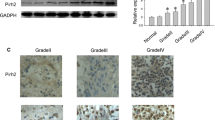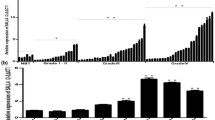Abstract
Spy1, a member of the Speedy/RINGO family, is a novel activator of cyclin-dependent kinases known to mediate cell cycle progression and cell survival in response to DNA damage. This study focused on the role of Spy1 in glioma oncogenesis. Immunohistochemistry and western blot analysis were performed to examine the expression of Spy1 in human glioma tissues and cell lines. Spy1 was frequently overexpressed in tumor tissues and cultured cells. Our data suggested that Spy1 expression positively correlated with the malignancy of gliomas. Altered expression of Spy1 led to changes in cell cycle processes, cyclin-dependent kinase 2 activity, and p27kip1 protein stabilization, ultimately disrupting cell growth rate. More importantly, high expression of Spy1 was associated with poor prognosis in patients with glioma, suggesting that Spy1 may be a novel independent prognostic predictor of survival for glioma patients. Collectively, this is the first report that Spy1 may play an essential role in the growth processes of human glioma.





Similar content being viewed by others
Abbreviations
- CDK:
-
Cyclin-dependent kinase
- KPS:
-
Karnofsky Performance Status
- PCNA:
-
Proliferating cell nuclear antigen
- RT-PCR:
-
Reverse transcriptase polymerase chain reaction
- GAPDH:
-
Glyceraldehyde-3-phosphate dehydrogenase
References
Barnes EA, Porter LA, Lenormand JL, Dellinger RW, Donoghue DJ (2003) Human Spy1 promotes survival of mammalian cells following DNA damage. Cancer Res 63:3701–3707
Bhattacharjee RN, Banks GC, Trotter KW, Lee HL, Archer TK (2001) Histone H1 phosphorylation by Cdk2 selectively modulates mouse mammary tumor virus transcription through chromatin remodeling. Mol Cell Biol 21:5417–5425
Brown NR, Noble ME, Endicott JA, Johnson LN (1999) The structural basis for specificity of substrate and recruitment peptides for cyclin-dependent kinases. Nat Cell Biol 1:438–443
Cheng A, Xiong W, Ferrell JE Jr, Solomon MJ (2005) Identification and comparative analysis of multiple mammalian Speedy/Ringo proteins. Cell Cycle 4:155–165
Dinarina A, Perez LH, Davila A, Schwab M, Hunt T, Nebreda AR (2005) Characterization of a new family of cyclin-dependent kinase activators. Biochem J 386:349–355
Ferby I, Blazquez M, Palmer A, Eritja R, Nebreda AR (1999) A novel p34(cdc2)-binding and activating protein that is necessary and sufficient to trigger G(2)/M progression in Xenopus oocytes. Genes Dev 13:2177–2189
Furnari FB, Huang HJ, Cavenee WK (1996) Molecular biology of malignant degeneration of astrocytoma. Pediatr Neurosurg 24:41–49
Gastwirt RF, Slavin DA, McAndrew CW, Donoghue DJ (2006) Spy1 expression prevents normal cellular responses to DNA damage: inhibition of apoptosis and checkpoint activation. J Biol Chem 281:35425–35435
Golipour A, Myers D, Seagroves T, Murphy D, Evan GI, Donoghue DJ et al (2008) The Spy1/RINGO family represents a novel mechanism regulating mammary growth and tumorigenesis. Cancer Res 68:3591–3600
Karaiskou A, Perez LH, Ferby I, Ozon R, Jessus C, Nebreda AR (2001) Differential regulation of Cdc2 and Cdk2 by RINGO and cyclins. J Biol Chem 276:36028–36034
Ke Q, Ji J, Cheng C, Zhang Y, Lu M, Wang Y et al (2009) Expression and prognostic role of Spy1 as a novel cell cycle protein in hepatocellular carcinoma. Exp Mol Pathol 87:167–172
King RW, Deshaies RJ, Peters JM, Kirschner MW (1996) How proteolysis drives the cell cycle. Science 274:1652–1659
Kirla RM, Haapasalo HK, Kalimo H, Salminen EK (2003) Low expression of p27 indicates a poor prognosis in patients with high-grade astrocytomas. Cancer 97:644–648
Kleihues P, Sobin LH (2000) World Health Organization classification of tumors. Cancer 88:2887
Kleihues P, Louis DN, Scheithauer BW, Rorke LB, Reifenberger G, Burger PC et al (2002) The WHO classification of tumors of the nervous system. J Neuropathol Exp Neurol 61:215–225, discussion 226-219
Lenormand JL, Dellinger RW, Knudsen KE, Subramani S, Donoghue DJ (1999) Speedy: a novel cell cycle regulator of the G2/M transition. EMBO J 18:1869–1877
Louis DN (1994) The p53 gene and protein in human brain tumors. J Neuropathol Exp Neurol 53:11–21
Maher EA, Furnari FB, Bachoo RM, Rowitch DH, Louis DN, Cavenee WK et al (2001) Malignant glioma: genetics and biology of a grave matter. Genes Dev 15:1311–1333
McAndrew CW, Gastwirt RF, Meyer AN, Porter LA, Donoghue DJ (2007) Spy1 enhances phosphorylation and degradation of the cell cycle inhibitor p27. Cell Cycle 6:1937–1945
Morgan DO (1996) The dynamics of cyclin dependent kinase structure. Curr Opin Cell Biol 8:767–772
Morgan DO (1997) Cyclin-dependent kinases: engines, clocks, and microprocessors. Annu Rev Cell Dev Biol 13:261–291
Morris GF, Mathews MB (1989) Regulation of proliferating cell nuclear antigen during the cell cycle. J Biol Chem 264:13856–13864
Nebreda AR (2006) CDK activation by non-cyclin proteins. Curr Opin Cell Biol 18:192–198
Nho RS, Sheaff RJ (2003) p27kip1 contributions to cancer. Prog Cell Cycle Res 5:249–259
Ohgaki H, Kleihues P (2005) Epidemiology and etiology of gliomas. Acta Neuropathol 109:93–108
Pines J (1995) Cyclins and cyclin-dependent kinases: a biochemical view. Biochem J 308(Pt 3):697–711
Porter LA, Dellinger RW, Tynan JA, Barnes EA, Kong M, Lenormand JL et al (2002) Human Speedy: a novel cell cycle regulator that enhances proliferation through activation of Cdk2. J Cell Biol 157:357–366
Porter LA, Kong-Beltran M, Donoghue DJ (2003) Spy1 interacts with p27Kip1 to allow G1/S progression. Mol Biol Cell 14:3664–3674
Rasheed BK, Wiltshire RN, Bigner SH, Bigner DD (1999) Molecular pathogenesis of malignant gliomas. Curr Opin Oncol 11:162–167
Reilly KM, Jacks T (2001) Genetically engineered mouse models of astrocytoma: GEMs in the rough? Semin Cancer Biol 11:177–191
Rich JN, Hans C, Jones B, Iversen ES, McLendon RE, Rasheed BK et al (2005) Gene expression profiling and genetic markers in glioblastoma survival. Cancer Res 65:4051–4058
Sanson M, Thillet J, Hoang-Xuan K (2004) Molecular changes in gliomas. Curr Opin Oncol 16:607–613
Sherr CJ (1996) Cancer cell cycles. Science 274:1672–1677
Sherr CJ, Roberts JM (1995) Inhibitors of mammalian G1 cyclin-dependent kinases. Genes Dev 9:1149–1163
Sherr CJ, Roberts JM (1999) CDK inhibitors: positive and negative regulators of G1-phase progression. Genes Dev 13:1501–1512
Solomon MJ, Kaldis P (1998) Regulation of CDKs by phosphorylation. Results Probl Cell Differ 22:79–109
Uhrbom L, Kastemar M, Johansson FK, Westermark B, Holland EC (2005) Cell type-specific tumor suppression by Ink4a and Arf in Kras-induced mouse gliomagenesis. Cancer Res 65:2065–2069
Wong AJ, Bigner SH, Bigner DD, Kinzler KW, Hamilton SR, Vogelstein B (1987) Increased expression of the epidermal growth factor receptor gene in malignant gliomas is invariably associated with gene amplification. Proc Natl Acad Sci U S A 84:6899–6903
Xiao A, Wu H, Pandolfi PP, Louis DN, Van Dyke T (2002) Astrocyte inactivation of the pRb pathway predisposes mice to malignant astrocytoma development that is accelerated by PTEN mutation. Cancer Cell 1:157–168
Zucchi I, Mento E, Kuznetsov VA, Scotti M, Valsecchi V, Simionati B et al (2004) Gene expression profiles of epithelial cells microscopically isolated from a breast-invasive ductal carcinoma and a nodal metastasis. Proc Natl Acad Sci U S A 101:18147–18152
Acknowledgments
We wish to thank Dr. Lisa A. Porter for supplying the Myc-tagged Spy1 construct. This work was supported by the National Basic Research Program of China (973 Program, nos. 2011CB910604 and 2012BC822104), the National Natural Science Foundation of China (nos. 31070723, 81070275, and 81172879), the Priority Academic Program Development of Jiangsu Higher Education Institutions (PAPD), and the College and University Natural Scientific Research Programme of Jiangsu Province (no. 11KJA310002).
Author information
Authors and Affiliations
Corresponding authors
Additional information
Li Zhang and Aiguo Shen both contributed equally to this work.
Rights and permissions
About this article
Cite this article
Zhang, L., Shen, A., Ke, Q. et al. Spy1 Is Frequently Overexpressed in Malignant Gliomas and Critically Regulates the Proliferation of Glioma Cells. J Mol Neurosci 47, 485–494 (2012). https://doi.org/10.1007/s12031-012-9709-5
Received:
Accepted:
Published:
Issue Date:
DOI: https://doi.org/10.1007/s12031-012-9709-5




